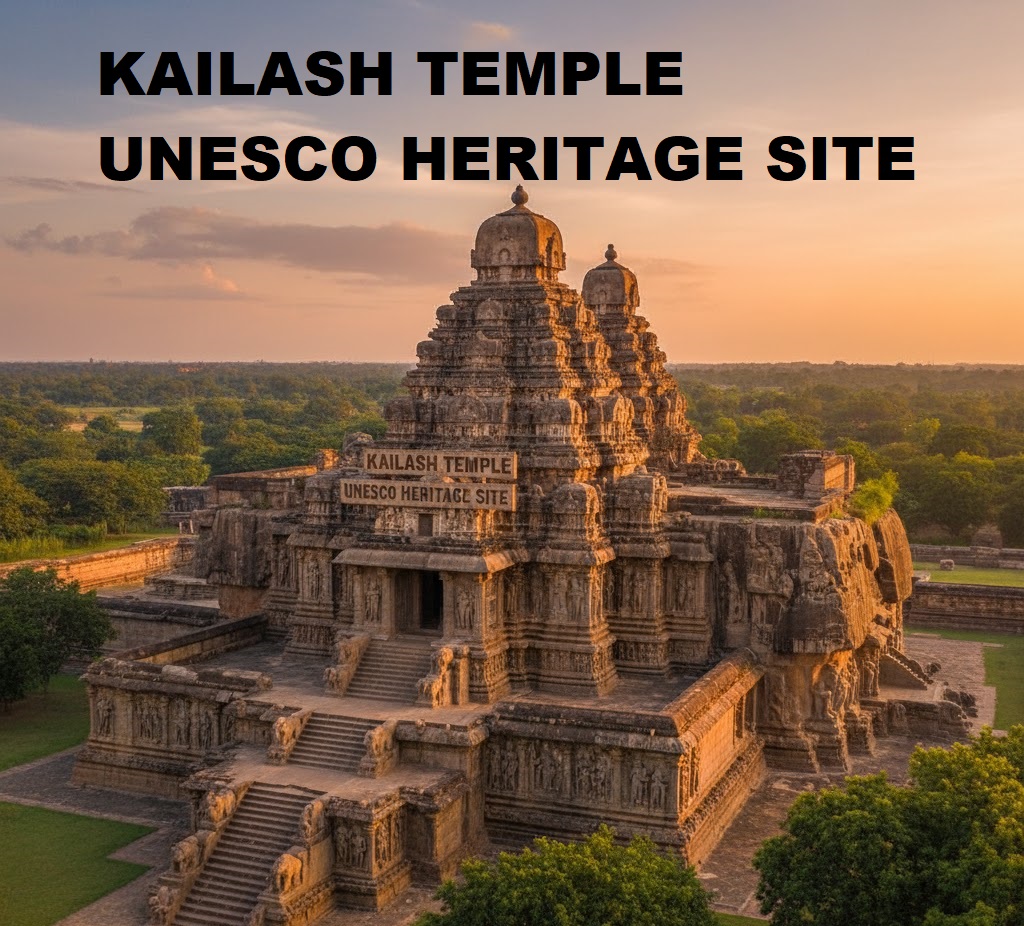Kailash Temple: Incredible India Heritage Quiz Challenge
Kailash Temple is an ageless symbol of India’s illustrious past and artistry. Sculpted completely out of one rock, Kailash Temple manifests the unparalleled craftsmanship and dedication of ancient Indian workers. Further, it creates curiosity among students to discover India’s cultural richness.
Through the Kailash Temple: Incredible India Heritage Quiz Challenge, students not only get an opportunity to test their knowledge but also form a rich appreciation of the creative brilliance of the Rashtrakuta dynasty.
Moreover, the quiz provokes young minds to relate historical facts with practical heritage, making learning more exciting and meaningful.
Educational Benefits of the Kailash Temple Heritage Quiz for Students
For school-going students, this heritage quiz is very useful as it increases overall awareness, enhances memory recall, and develops analytical thinking.
It also supplements school study materials on art, architecture, and Indian history.
Such interesting activities also foster respect for India’s ancient heritage and motivate students to be proud of their nation’s achievements.
Finally, the Kailash Temple: Incredible India Heritage Quiz Challenge makes history a participative learning process that reinforces knowledge and
confidence among students studying for academic as well as competitive examinations.
Top 10 Historical Events That Changed the World Forever
Kailash Temple: Incredible India Heritage Quiz Challenge
1. Introduction: A Temple Beyond Imagination
Carved from a single stone, this temple is such that even historians, engineers, and travelers get amazed about it till date.
Built in the 8th century, this is the peak of Indian rock-cut architecture, where creativity meets religious significance.
While the other temples were constructed with stones that were joined together, Kailash Temple was carved from the top down,
i.e., the craftsmen began from the top and moved downwards—a nearly impossible engineering feat at that time.
Further, this temple is dedicated to Lord Shiva and symbolizes Mount Kailash, which was his paradise.
Every carving, pillar, and statue reflects immense devotion and unparalleled craftsmanship.
Thus, despite more than 1,200 years, it is an alive testimony to India’s ancient wisdom and cultural endurance.”
2. Historical Context of Kailash Temple
First, King Krishna I of the Rashtrakuta dynasty commissioned the building of the Kailash Temple in the 8th century CE.
The Rashtrakutas, being great patrons of culture and the arts, wanted a temple that was divine, reflecting spiritual power as well as royal splendor.
They constructed the temple as part of the Ellora Caves complex, which comprises Hindu, Buddhist, and Jain monuments—a testament to India’s rich
tradition of religious harmony.
Inscriptions and architectural analyses indicate that the constructors took Mount Kailash, the symbolic residence of Lord Shiva, as the model for
constructing the Kailash Temple.
They did not just construct it as a temple but also as a declaration of imperial power and a manifestation of Hindu thought.
The Rashtrakuta rulers dedicated this temple as a gift to God, taking humanity’s creativity to a task of divine devotion.
Even to this day, the monument remains one of early medieval India’s highest accomplishments.
Unfolding the Past: Exploring Timelines and Historical Sources
3. The Uniqueness of the Rock-Cut Architecture
The building of the Kailash Temple was unconventional.
Rather than constructing stones piecemeal, the builders excavated the entire temple from a single piece of monolithic rock.
They started from the top of the basalt hill and progressed downwards with no margin for error.
Their work required exceptional precision, planning, and knowledge of the natural structure of the rock.
The temple complex measures approximately 200 feet long, 100 feet broad, and 100 feet tall, with shrines, courtyards, halls, and carved galleries—all
precisely sculpted into the rock face.
The laborers broke off almost 200,000 tons of rock altogether by hand, without the assistance of heavy machinery.
Their engineering expertise and profound piety transformed craftsmanship into worship itself.
Engineers even now are amazed by the immaculate symmetry, stability, and sheer scale of this rock-cut wonder.
12 Places To Visit Near Me – In Chhattisgarh
4. Mythological Inspiration and Symbolism
Hindu spirituality and mythology profoundly influence the architecture of the Kailash Temple.
The architects represented the actual Mount Kailash, which is the abode of Lord Shiva and Goddess Parvati, with this magnificent temple.
Every component of the complex—the mandapa (hall), shikhara (spire), and inner sanctum—complies with the old Hindu principles of architecture as
outlined in the Shilpa Shastras.
The craftsmen etched tales from the Mahabharata and Ramayana on the temple walls so that the sculptures could impart spiritual and moral lessons on
devotees.
Through its architecture, the temple reflects order in the universe, bridging heaven with earth in harmony.
The constructors even oriented the temple deliberately so that sunlight falls on the sanctum at particular times of day, imbuing it with divine splendor.
Finally, the Kailash Temple exists not just as a work of architecture but as a holy symbol that bridges the material and spiritual realms via stone.
क्या गणेश जी एक आधुनिक कंप्यूटर के डिज़ाइन थे ?
5. Engineering Genius: Strategies and Challenges
Contemporary experts still stand in awe of the engineering genius of the Kailash Temple.
Historians estimate that the ancient builders excavated virtually 200,000 tons of rock to form this piece of architectural marvel.
However, they made not a single visible mistake or structural flaw.
The craftsmen sculpted beautifully symmetrical pillars, doorways, and staircases with evidence of advanced geometry knowledge and accurate
measurement.
Utilizing just plain tools—chisels, hammers, and iron rods—the artists based their work on their skill, experience, and intuition in lieu of mechanical aids.
They had the perpetual challenge of keeping the temple stable, aware that one miscalculated cut while working downwards would have led to the
destruction of the entire monument.
Finishing such a wonder within 18 to 20 years reflects their marvelous commitment and productivity.
By merging artistic creativity with engineering brilliance, the ancient Indian artisans reflected unmatched expertise.
Even now, their efforts continue to amaze contemporary architects and push the boundaries of contemporary architecture.
Was the Dark Age in Europe Really Dark? Uncovering the Truth About Medieval Europe
6. Sculptural Beauty and Artistic Detailing
Each turn within the Kailash Temple speaks of something through its carvings.
The walls, pillars, and ceilings are decorated with intricate sculptures depicting gods, celestial beings, animals, and mythological events.
Especially noteworthy are the images of Lord Shiva in different forms—Nataraja, Ardhanarishvara, and Ravana hoisting Mount Kailash.
The rich carvings of elephants and lions below represent strength and firmness.
Every figure is sculpted so realistically that even tiny jewelry and facial expressions are clearly discernible.
The artistry of the temple not only venerates Hindu mythology but also reflects the cultural strength of its times.
The contrast between gigantic architectural structures and intricate artistic details shows the incredible talent of old sculptors.
Walking among these carvings is like entering a stone book where all the surfaces hum with stories of loyalty, strength, and endless creativity.
7. Secrets and Unanswered Questions
Scholars have carried out many researches, but mysteries of the Kailash Temple are still not fully solved.
Experts are still arguing how ancient constructors managed to build such a large monument in a short while with only plain tools.
Scholars still wonder how the artisans worked with perfect alignment and proportion while cutting inward from solid rock.
Some scientists even propose that the constructors could have employed prehistoric measurements or forgotten technologies.
Since no record in history mentions the architects or artists who built it, the temple’s origin is an ongoing mystery.
Its endurance of myriad earthquakes and centuries speaks volumes about the unparalleled engineering excellence of those times.
While legends say that it was built through divine intervention, the actual marvel is the ingenuity of human craftsmanship.
Even now, the Kailash Temple remains silent and strong, guarding the secrets of a forgotten era which may never be revealed to humankind.
History Class 6 ICSE Lesson Plan: Activity-Based Learning on The Early Vedic Civilization
8. Legacy and Status as a World Heritage Site
Presently, the Kailash Temple is a proud part of the Ellora Caves, a UN World Heritage Site, renowned for its ancient and cultural history.
Scholars, architects, and devotees from across the globe go to the temple to marvel at its majesty and religious environs.
Aside from its physical beauty, the temple reflects India’s legacy of innovation, piety, and artistic excellence.
It serves as an inspiration for modern-day architects and historians, who learn from it as a template of ancient engineering excellence.
As travelers pass through its corridors, they are not only face to face with a rock monument but a vibrant reminder of the power of human imagination,
belief, and resilience.
The Kailash Temple is not just a masterpiece—it is evidence of what human hands can do when spearheaded by divine insight and relentless
perseverance.
Class VI History Chapter 7 Lesson Plan: Ashoka, The Emperor Who Gave Up War
Heritage Quiz Questions Based on Kailash Temple
As we know, the Ellora Kailash Temple is one of India’s most stunning heritage marvels.
moreover, it was carved out of a single rock more than 1,200 years ago.
It showcases the artistic excellence, engineering prowess, and sincere religiosity of the ancient Indian craftsmen.
In an effort to make students discover this wonder in a fun and engaging manner, here are 10 Heritage Quiz MCQs on the Kailash Temple.
Therefore, these are not just questions to test your knowledge but also to make you appreciate India’s rich cultural and architectural heritage.
Let’s find out how well you understand this wonderful monument in honor of Lord Shiva!
Heritage Quiz Round 1
1. Where is the Kailash Temple situated in India’s famous cave complex?
A) Ajanta Caves
B) Elephanta Caves
C) Ellora Caves
D) Badami Caves
Answer: C) Ellora Caves
2. In whose reign was the construction of the Kailash Temple undertaken?
A) Maurya Dynasty
B) Gupta Dynasty
C) Rashtrakuta Dynasty
D) Chola Dynasty
Answer: C) Rashtrakuta Dynasty
3. King Krishna I is reputed to have ordered the construction of the Kailash Temple. He was from which era?
A) 5th Century CE
B) 8th Century CE
C) 10th Century CE
D) 12th Century CE
✅ Answer: B) 8th Century CE
4. To which Hindu god is the Kailash Temple dedicated?
A) Lord Vishnu
B) Goddess Parvati
C) Lord Shiva
D) Lord Brahma
✅ Answer: C) Lord Shiva
5. How is the Kailash Temple special compared to other temples of ancient times?
A) It was constructed with marble
B) It was carved from one rock
C) It was constructed with wood and clay
D) It was built underwater
✅ Answer: B) It was carved from one piece of rock
Heritage Quiz Round 2
6. The temple symbolizes which mythical mountain thought to be the residence of Lord Shiva?
A) Mount Meru
B) Mount Everest
C) Mount Kailash
D) Mount Vindhya
✅ Answer: C) Mount Kailash
7. Roughly how much rock was excavated to carve out the Kailash Temple?
A) 20,000 tons
B) 50,000 tons
C) 100,000 tons
D) 200,000 tons
✅ Answer: D) 200,000 tons
8. In what architectural method was the Kailash Temple constructed?
A) Bottom-up construction
B) Circular excavation
C) Top-down excavation
D) Sideways carving
✅ Answer: C) Top-down excavation
9. What UNESCO designation does the Kailash Temple enjoy at present?
A) UNESCO Intangible Heritage
B) UNESCO World Heritage Site
C) UNESCO Cultural Innovation Award
D) UNESCO World Wonder Title
✅ Answer: B) UNESCO World Heritage Site
10. What ancient epics are represented in the wall carvings of the Kailash Temple?
A) Rigveda and Atharvaveda
B) Ramayana and Mahabharata
C) Puranas and Upanishads
D) Bhagavad Gita and Arthashastra
✅ Answer: B) Ramayana and Mahabharata
Kailash Temple: Incredible India Heritage Quiz Challenge
Conclusion:
Kailash Temple is a glorious representative of the artistic excellence and spiritual passion of India.
With The Kailash Temple: Incredible India Heritage Quiz Challenge, students can engage actively with one of the world’s greatest rock-cut monuments.
In addition, the Kailash Temple showcases how ancient Indian engineers and sculptors transformed solid rock into an awe-inspiring marvel that still
amazes the world today
Therefore, as we commemorate such everlasting heritage, it is our duty to protect and propagate these marvels for generations to come.
In short, learning about this temple by playing quizzes not only increases knowledge but also generates pride in India’s rich past.
So, are you prepared to take the next step and unveil more concealed treasures of India’s heritage?





0 Comments